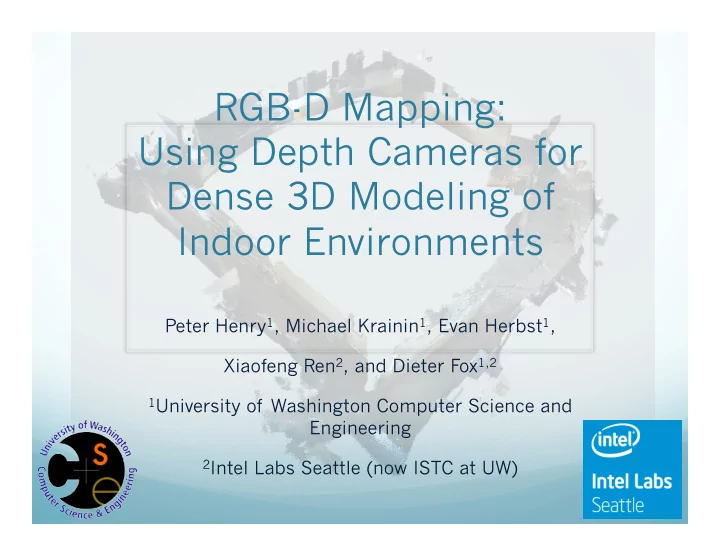

RGB-D Mapping: Using Depth Cameras for Dense 3D Modeling of Indoor Environments Peter Henry 1 , Michael Krainin 1 , Evan Herbst 1 , Xiaofeng Ren 2 , and Dieter Fox 1,2 1 University of Washington Computer Science and Engineering 2 Intel Labs Seattle (now ISTC at UW) 1
The Kinect 2
PrimeSense Technology 3
RGB-D Data 4
5
Related Work SLAM [Davison et al, PAMI 2007] (monocular) [Konolige et al, IJR 2010] (stereo) [Pollefeys et al, IJCV 2007] (multi-view stereo) [Borrmann et al, RAS 2008] (3D laser) [May et al, JFR 2009] (ToF sensor) Loop Closure Detection [Nister et al, CVPR 2006] [Paul et al, ICRA 2010] Photo collections [Snavely et al, SIGGRAPH 2006] [Furukawa et al, ICCV 2009] 6
System Overview 1. Frame-to-frame alignment 2. Loop closure detection and global consistency 3. Map representation 7
Alignment (RANSAC) Visual features (from image) in 3D (from depth) RANSAC alignment requires no initial estimate Requires sufficient matched features 8
RANSAC Details Feature Detector / Descriptor Options SIFT (SiftGPU) SURF FAST Detector / Calonder Descriptor (All available in OpenCV) Matching: L2 descriptor distance Either SIFT style matching or window matching 9
RANSAC Failure Case 10
Alignment (ICP) Does not need visual features or color Requires sufficient geometry and initial estimate 11
ICP Failure Case 12
Joint Optimization (RGBD-ICP) 13
Optimal Transformation 14
Two-Stage Alternative 15
Loop Closure Sequential alignments accumulate error Revisiting a previous location results in an inconsistent map 16
17
Loop Closure Detection Detect by running RANSAC against previous frames Pre-filter options (for efficiency): Only a subset of frames ( keyframes ) Only keyframes with similar estimated 3D pose Place recognition using vocabulary tree Post-filter (avoid false positives) Estimate maximum expected drift and reject detections changing pose too greatly 18
Loop Closure Correction (TORO) TORO [Grisetti 2007]: Constraints between camera locations in pose graph Maximum likelihood global camera poses 19
Loop Closure Correction (SBA) Minimize reprojection error of features 20
Comparison (TORO) 21
Comparison (SBA) 22
A Second Comparison TORO SBA 23
SBA on a tricky sequence 24
25
Map Representation: Surfels Surface Elements [Pfister 2000, Weise 2009, Krainin 2010] Circular surface patches Accumulate color / orientation / size information Incremental, independent updates Incorporate occlusion reasoning 750 million points reduced to 9 million surfels 26
27
Experiments Reprojection error is better for RANSAC: Errors for variations of the algorithm: Timing for variations of the algorithm: 28
Experiments: Overlay 1 29
Experiments: Overlay 2 30
Application: Measurements 31
Application: Quadrocopter Collaboration with Albert Huang, Abe Bacharach, and Nicholas Roy from MIT 32
33
34
35
Occupancy Map 36
37
Resulting Map 38
Conclusion Kinect-style depth cameras have recently become available as consumer products RGB-D Mapping can generate rich 3D maps using these cameras RGBD-ICP combines visual and shape information for robust frame-to-frame alignment Global consistency achieved via loop closure detection and optimization (RANSAC, TORO, SBA) Surfels provide a compact map representation ROS + OpenCV are powerful tools to enable these applications 39
Open Questions Which are the best features to use? How to find more loop closure constraints between frames? What is the right representation (point clouds, surfels, meshes, volumetric, geometric primitives, objects)? How to generate increasingly photorealistic maps? Autonomous exploration for map completeness? Can we use these rich 3D maps for semantic mapping? 40
Thank You! 41
Links www.ros.org The following have nice ROS integration but also work separately: http://opencv.willowgarage.com/wiki/ http://www.pointclouds.org/ Paper link on this page: http://www.cs.washington.edu/homes/fox/abstracts/ 3d-mapping-iser-10.abstract.html 42
Recommend
More recommend